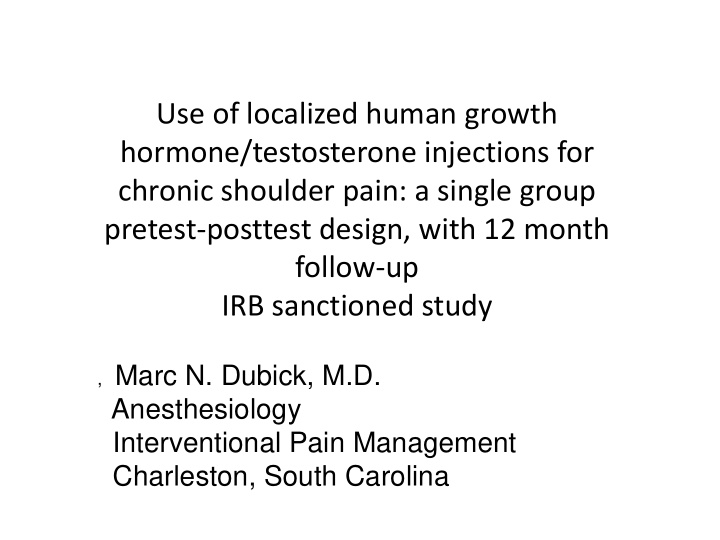



Use of localized human growth hormone/testosterone injections for chronic shoulder pain: a single group pretest-posttest design, with 12 month follow-up IRB sanctioned study , Marc N. Dubick, M.D. Anesthesiology Interventional Pain Management Charleston, South Carolina
Objective • Investigate the feasibility and safety of a new injection technique for the treatment of chronic shoulder pain. • Localized hGH/testosterone injections at capsular ligaments and labrum in individuals who presented with chronic shoulder pain with a proposed diagnosis of capsular pain and/or laxity.
Outcome • Measured at 12 months following injections Setting • Community based hospital affiliated office and a private block suite
P ositive Findings Physical Examination Obrien’s Active Compression Test Seated Apprehension Test Internal/External Rotation Rotator cuff testing
Areas Treated Inferior, middle, superior glenohumeral ligaments on both glenoid and humeral sides Long head of the bicep tendon attachment at superior aspect of the glenoid Rotator cuff attachments on humerus when indicated
Patient numbers • 23 consecutive patient shoulders met inclusion criteria • 19 provided informed consent • 16 completed all aspects of the study
Figure 2. Shoulder Pain and Disability Index (SPADI) scores pre- and post-test. 31pts Figure 2. Shown above are the point estimates for the mean scores and 95% confidence limits for the SPADI scores, which shows a mean reduction of 31.8 points (95% CI: 20.7- 43.0, p<.0001). The minimal detectable change is 18.1 points, with a minimal clinically- important difference of 13.2 points (Schmitt & Di Fabio, 2004).
Figure 3. Shoulder Pain Scores (SPS) scores pre- and post-test. 37pts Figure 3. The point estimates for the mean scores and 95% confidence limits for the SPS scores, which shows a mean reduction of 36.7 points (95% CI: 24.0-49.4, p<.0001).
Figure 4. Mankowski Pain Scale Index (MPSI) scores pre- and post- test. 3.1 pts Figure 4. The point estimates for the mean scores and 95% confidence limits for the MPSI scores, which shows a mean reduction of 3.1 points (95% CI: 2.0-4.2, p<.0001).
Significant improvement in the participants’ report of symptom decrease of 76%
Patients Who Withdrew • Two underwent surgery prior to the 12 month time frame • One switched to another interventional therapy prior to the 12 month follow-up • One lost to follow-up
Conclusion • Safe • Reasonable expectation that treatment is beneficial for those who met diagnostic criteria • Further study of the procedure may be warranted
hGH • Protein hormone • Strongest anabolic hormone in the body • Stimulates tissue growth, cell reproduction, regeneration, protein synthesis • Increases wound collagen content and wound tensile strength • Bonds to hGH receptor site on target cells • Is an activating factor for macrophages
Testosterone • Steroid hormone • Strong androgenic and moderate anabolic actions • Levels decrease with chronic injury, pain, and stress • Decrease levels impair wound healing • Bonds to androgenic receptor site on target cells
Initiating Wound Healing • Create acute injury by needling each treatment area at the enthesis, causing micro bleeding. • All blood components are present, including the resident macrophages which are felt to control wound healing through the production of growth factors and attracting stem cells to the site. • Vital interactions take place in wound healing simultaneously among hGH, Testosterone, IGF-1, Growth Factors, Macrophages, Fibroblasts, Platelets, Stem Cells
Injection Medication per 10 cc • Omnitrope (Sandoz) recombinant human growth hormone 3u/10 cc volume • Testosterone aqueous 12.5 mg woman, 25 mg men per 10cc volume • Lidocaine 1% PF 4cc • NaCl PF to 10cc • Number of procedures average 3 spaced 3-4 weeks apart
Recovery Time Not a quick fix Wound healing takes place over a 3- 6 month period Takes time for newly formed connective tissue to mature into functional ligament tissue
Orthobiologics and Regenerative Medicine Revolution Autologous Blood Bone Marrow Concentrate Cartilage Regeneration Hgh/testosterone PRP Stem Cells
Recommend
More recommend